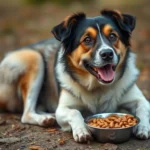
Introduction
Proper nutrition is crucial for active dogs since their energy levels and physical demands are significantly higher than those of more sedentary breeds. An active dog, whether a working breed, a sporting companion, or simply a playful family pet, requires a balanced diet to support their increased activity. Poor nutrition can lead to a host of problems, from fatigue and poor performance to long-term health issues like obesity, joint problems, and a weakened immune system.
This article aims to provide insights into the best dog foods for active dogs, helping pet owners make informed choices that align with their dog’s lifestyle and nutritional needs.
Understanding the Nutritional Needs of Active Dogs
Defining Active Dogs
Active dogs typically exhibit high energy levels and enjoy regular physical activity. These dogs may include breeds like Border Collies, Labrador Retrievers, and Siberian Huskies. Characteristics of active dogs can vary by age, breeding, and individual personality, but they usually require more calories and nutrients than less active dogs.
Key Nutritional Components
To meet the demands of their lifestyle, active dogs need a diet rich in specific nutrients:
Proteins
Proteins are essential for muscle recovery and energy. They help in repairing tissues after strenuous activities and play a vital role in overall growth. For active dogs, high-quality protein sources such as chicken, beef, and fish should make up a significant portion of their diet.
Fats
Fats are a concentrated energy source and are crucial for sustaining longer periods of activity. Fatty acids, particularly Omega-3 and Omega-6, provide not only energy but also support skin and coat health. Look for dog foods that include healthy fat sources like fish oil and chicken fat.
Carbohydrates
Carbohydrates provide quick energy and are necessary for endurance during activities. They also contribute to a healthy digestive system. Complex carbohydrates, such as whole grains and vegetables, can offer sustained energy release, keeping your active dog fueled throughout the day.
Vitamins and Minerals
Essential vitamins and minerals support overall health and immune function. Nutrients such as calcium, phosphorus, and Vitamin D are crucial for bone health, while antioxidants like Vitamin E and C help combat oxidative stress from physical activity.
Factors to Consider When Choosing Dog Food for Active Dogs
Life Stage
The nutritional needs of dogs vary significantly with their life stage. Puppies require a higher caloric intake and specific nutrients for growth, while adult dogs need a balanced diet to maintain their health. Senior dogs may require adjustments to their diet, focusing on joint health and easier digestibility.
Breed-Specific Needs
Different breeds have unique dietary requirements. For example, giant breeds might need a diet that supports bone health and growth, while smaller, agile breeds might require more protein for muscle maintenance. Always consider your dog’s breed when choosing food.
Allergies and Sensitivities
Some dogs may have food allergies or sensitivities that can affect their health and performance. Common allergens include grains, chicken, and beef. If your dog shows signs of allergies, consider hypoallergenic dog food options that exclude these ingredients.
Activity Level
Tailoring your dog’s diet based on their daily activity level is vital. If your dog participates in high-energy activities like agility training or long hikes, they will need a more calorie-dense diet than a dog that enjoys leisurely walks.
Types of Dog Food Suitable for Active Dogs
Dry Kibble
Dry kibble is the most common type of dog food and offers several advantages for active dogs. It’s convenient and can be stored easily, making it a popular choice for busy pet owners. However, it’s essential to select high-quality kibble designed for active dogs, which will be richer in protein and fats.
Recommended Brands:
– Orijen Original Dry Dog Food: High protein content (38% from fresh, regional ingredients)
– Blue Buffalo Wilderness Dog Food: Grain-free with real meat as the first ingredient
Wet Food
Wet food can be beneficial for hydration and is often more palatable for dogs. For active dogs, wet food can provide a tasty treat after rigorous activity, ensuring they stay hydrated.
Best Options:
– Merrick Grain-Free Texas Beef & Sweet Potato: High protein and fat content
– Wellness CORE Grain-Free: Rich in nutrients for active dogs
Raw Diet
A raw diet can be appealing to some pet owners due to its natural approach. Advocates argue that a raw diet can enhance coat condition, energy levels, and overall health. However, transitioning to a raw diet requires careful planning to ensure nutritional balance.
Tips for Transitioning:
1. Start with small amounts of raw food mixed with current kibble.
2. Gradually increase the proportion of raw food over a week.
3. Monitor for any digestive issues or adverse reactions.
Homemade Dog Food
Homemade meals can be tailored to meet your dog’s specific needs. When preparing homemade dog food, it’s crucial to include various protein sources, vegetables, and grains to ensure a balanced diet.
Sample Recipe:
– Chicken and Vegetable Stew:
– Ingredients: Chicken thighs, carrots, peas, sweet potatoes, brown rice.
– Preparation: Cook chicken thoroughly, mix in chopped vegetables and rice, and simmer until well combined.
Top Recommended Dog Foods for Active Dogs
High-Protein Formulas
For active dogs, a high-protein diet is essential for muscle maintenance and recovery. Here are some top products:
- Taste of the Wild High Prairie Canine Recipe: 32% protein from real roasted bison and roasted venison.
- Nutro Ultra Grain-Free Dog Food: 30% protein with a blend of high-quality meats.
High-Fat Options
Fat is crucial for sustaining energy levels, especially for working dogs. Consider these options:
- Victor Hi-Pro Plus Dry Dog Food: Contains 30% protein and 20% fat, ideal for high-energy dogs.
- Canidae All Life Stages Multi-Protein Formula: Offers 26% protein and 16% fat for all active dogs.
Grain-Free vs. Grain-Inclusive
Choosing between grain-free and grain-inclusive diets can be challenging. Grain-free diets are often favored for dogs with sensitivities, while grain-inclusive options can provide beneficial nutrients.
Grain-Free Pros:
– May help with allergies.
– Often higher in protein and fat.
Grain-Inclusive Pros:
– Can aid digestion.
– Provides essential fiber.
Brands to Consider:
– Grain-Free: Acana Singles + Wholesome Grains
– Grain-Inclusive: Royal Canin Size Health Nutrition
How to Transition Your Dog to a New Food
Signs Your Dog Needs a Diet Change
If your dog displays lethargy, weight fluctuations, or a lack of enthusiasm during activities, it may be time to reevaluate their diet. Observing energy levels and overall health can guide dietary adjustments.
Gradual Transition Process
To avoid digestive upset, gradually introduce new food over 7-10 days:
- Start with 25% new food mixed with 75% old food.
- Increase new food to 50% after a few days.
- Continue to adjust until your dog is on 100% new food.
Monitoring and Adjusting
Keep an eye on your dog’s response to the new food. Look for changes in energy levels, coat condition, and overall demeanor. Adjust portions as needed to ensure your dog maintains a healthy weight and energy level.
Common Myths About Dog Nutrition
Debunking Misconceptions
Many myths about dog nutrition can lead to confusion among pet owners. Here are a few common misconceptions:
- Grain is bad for all dogs: Not all dogs have grain allergies. Many dogs thrive on diets that include grains as a source of energy and fiber.
- Raw diets are inherently better: While some advocate for raw feeding, it’s essential to ensure the diet is nutritionally balanced. Raw diets can pose risks if not properly managed.
Evidence-Based Explanations
Research shows that individual dietary needs vary widely among dogs. Always consult with a veterinarian to tailor the diet to your dog’s specific needs.
Conclusion
Choosing the best dog foods for active dogs is vital to ensuring their health, energy, and overall well-being. By understanding their unique nutritional requirements and considering factors like life stage, breed, and activity level, you can make informed choices that will keep your furry friend happy and healthy. Prioritize a balanced diet that meets their energy demands, and you’ll notice the positive impact on their performance and vitality.









